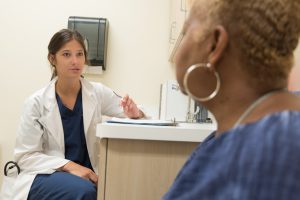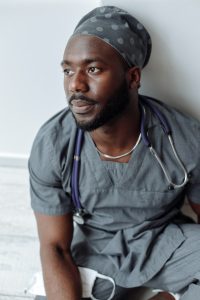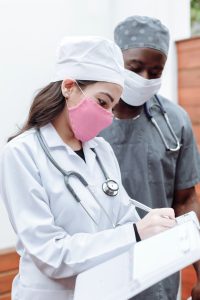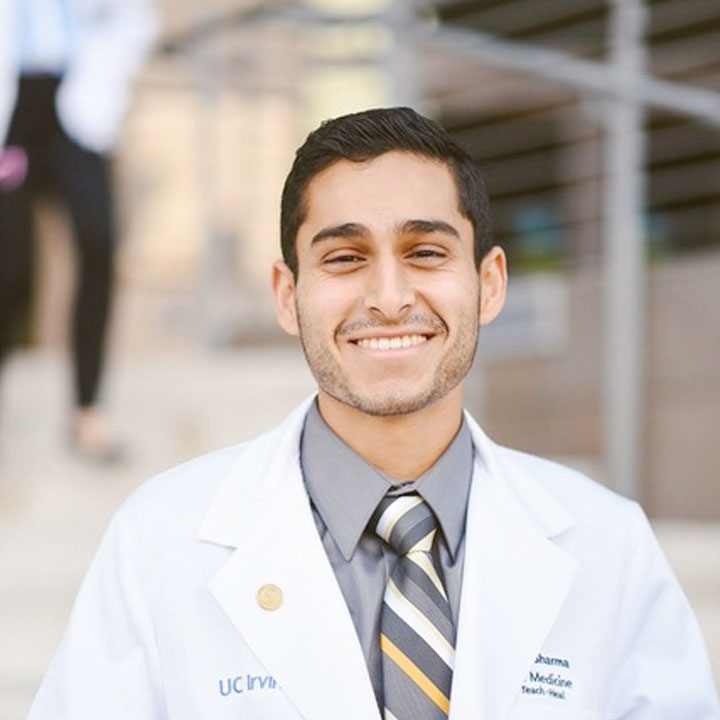A couple of years ago, two med students—and roommates—at the University of California, Irvine starting coming back from classes, and talking about their days.
Both riding the med school rollercoaster, Ajay Nair Sharma and Daniel Azzam found that their stories had plenty in common. Their friends’ stories did, too.
The seed for ‘Diary of a Med Student,’ the duo’s recently published book, was planted.
The biggest preconception I had [of med school] was that it’s a very linear process … in reality, there are a lot of ups and downs.
Featuring more than 100 stories and vignettes, the book explores the good, bad, ugly, hilarious – and profound moments that make up med school.
Currently in the final stages of his MD and MBA degrees at UC Irvine, Azzam is planning on a career as an eye surgeon.
A talented medical artist and prominent student leader at UC Irvine, Sharma is finishing up his medical and business studies. He plans to become a dermatologist, focusing on the treatment of skin cancer.
Recently, OnlineMedEd spoke with Sharma and about the inspiration behind ‘Diary of a Med Student’, what the highs and lows of med school feel like, and how different the med student experience is now compared to previous generations of doctors.
Hi Ajay, thanks for your time. How did ‘Diary of a Med Student’ come together? What was the inspiration for writing it?
“My roommate Daniel Azzam and I were in our third year—in clinical rotations—at medical school. We found ourselves coming home every day, and recounting everything that happened that day.
“For us, it was kind of a relaxing way to just expel what we were feeling that day; whether it was good, bad, funny or sad. It was just really a way to ‘get out’ what we did that day, and, honestly, it soon became our favorite part of the day.
“We enjoyed talking about our own experiences, but sooner or later we started sharing them with our friends as well. We quickly found out that, not only did they enjoy hearing our stories, but they had stories themselves.
“I think that’s what really lit up the lightbulb; everyone had their own stories to share, and all we had to do was find a platform for that.”
Before you entered med school yourself, what were some of the preconceptions you had about the experience? How much have those views changed over time?
“The biggest preconception I had was that it’s a very linear process. That every day, you’re just improving as a doctor-in-training to a point when you’re finally a doctor.
“In reality, there are a lot of ups and downs. While after four years you are a smarter, more accomplished doctor-in-training, it is not as linear as what you may have expected. There are days that are really incredible and amazing; far greater than any you could have expected as a medical student.

“Then there are other days where you don’t get to do a whole lot, or a recommendation you proposed is not appreciated by the team – or was incorrect. That’s just the nature of learning, so I don’t think that’s necessarily a bad thing, but I think it’s something that you might not realize when you start med school.
“Just because you’re halfway through your third year or halfway through med school, that doesn’t mean that everything is going to go well. There are going to be days on a micro-scale that are harder than others, but, I think, in a bigger picture, you do improve.
“Overall, medical school has absolutely been the greatest time in my life. I’m just so grateful every day to do what I love, and be able to train to make a difference moving forward.”
You mention ‘high highs’ and ‘low lows’. How big is the gap between the two?
“The good days open you up to things you didn’t know you had, in terms of appreciation and intrinsic reward that you didn’t know was there. I think there is something very unique about talking to a patient or talking to a patient’s family, and having that human connection where they express their gratitude or appreciation about what you did for them.
“Oftentimes that can range from an actual medical recommendation you provide, utilizing the knowledge you gained from all of your hard work in medical school, or it could just stem from you being there for the patient, showing empathy and really taking the time to understand their story.
That human connection, that patient-doctor connection, is so unique; it’s really not something you can appreciate unless you are involved. For me, I don’t think anything beats that.
“That human connection, that patient-doctor connection, is so unique; it’s really not something you can appreciate unless you are involved. For me, I don’t think anything beats that.
“On the opposite end, yes, there are the low lows. They definitely exist, and I think that was one of the focuses of our book. Students should know that they are not alone if they feel low, or have experiences that get them down.
“To know that there are high highs out there and everyone in medical school is going through similar things. Some of the low lows might be in the doldrums of studying in your first couple of years. With board exams, you might go a couple of days not leaving your house or the library. You could just study non-stop.
“In the moment, that is tough because you look outside, it might be a beautiful day and you see your life passing by.
“I think you always have to keep in mind that bigger picture and knowing that it’s all for a good purpose, and it’s all to help your patients.
Regardless of the stories’ subject matter, a big chunk of your book focuses on student mental health. How big of an issue is it in modern med school?
“Medical student burnout, and mental wellness, are such critical issues in medical education, today. The pressures of medical school itself can have a major impact on students’ mental health and wellness.
“For a variety of reasons, there are many barriers to express these pressures and mixed feelings. There are study time constraints, a culture that historically promotes putting your head down and working, and simply just a lack of opportunity to reflect.
“I think all of those lead many students to internalize their feelings. What we realized from talking to our friends is everybody has a story to share. We thought that the process of reflecting and writing, and sharing your story, could be really cathartic.
“We wanted a way for med students across the country to express these emotions, and express these feelings. Once we opened up our submissions, they really just blew us away.

“Everyone is so unique, and has their unique story, but the issues or problems med students face and deal with internally, are things you may never think of.
“[Another] theme in our book is also racial inequality, and social injustice. There are a lot of examples within our book of medical students from minorities or mixed backgrounds experiencing these feelings, from patients or just internally. To have them share those stories is not only very powerful, but very brave.
“The book itself opened our eyes. The challenges we face, in 2020, are so much more varied that what you think the classic issues or problems of a medical student might face.”
To be a med student in 2020 is very different to being a med student in previous generations. What do those who may have attended med school in the past not understand about the experience, today?
“First of all, medical school is such an accomplishment and it’s difficult no matter when you complete it. I’m sure the doctors who are a little more experienced had to go through challenges we never faced, and they faced difficulties and obstacles that they overcame that, for us, we’d never think of.
“But for med students in 2020, there are new problems that we face that more experienced doctors may not appreciate.
The global pandemic has really turned medical education, and medicine in general, upside down. Being able to learn from this experience, both in the short term … and long term, will help us combat viruses and pandemics in the future.
“Obviously, right away, there’s the accessibility of information. Patients are so well-informed these days. That’s an absolutely great thing, in terms of giving power to patients and being their own advocate, but it also puts an additional responsibility on the doctor to navigate these conversations, and reconcile what the patient knows and what you know with your expert opinion and experience. I think that’s something the new generation of doctors have to deal with quite frequently.
“I also think that, with healthcare becoming accessible, we see a lot more diversity in our patients. A lot more is coming out about systematic barriers in healthcare and how we can overcome that.
“Our role as physicians is to help overcome different health inequities, and how we can include social determinants of health into the best treatment plans for our patients – I think that’s an area that is really fast growing, and is something doctors of today should be keeping in the forefront of their minds.
“The LGBTQI community is another that’s been historically underserved. Doctors of today are understanding that we have to do our part in really learning more about what this population needs, and how we can do our part in treating everyone equally and giving them the healthcare they need.”
“The global pandemic has really turned medical education, and medicine in general, upside down. Being able to learn from this experience, both in the short term … and long term, will help us combat viruses and pandemics in the future.”
What was something that turned up, in your writing of ‘Diary of a Med Student’, that was unexpected, but also had an important message behind it?
“I think that word ‘relatable’ is the big one.
“Every medical student knows the feeling when they go into a patient’s room, and take a history, [but] when they return with the attending, it seems like the patient has a new story that you’ve never heard before.
“Similarly, a med student thinks they’ve had a great rotation, really connected well with the doctor and the patients, and next thing you know, the evaluation is just average. I think everyone knows that feeling … or the feeling of studying for anatomy and really being confident in your answer, and then finding you’re the only person in your class that choose that answer.

“These are moments that, in the moment, might seem shocking or like the world is ending. [But] it is very comforting to know that medical students across the world know exactly how you’re feeling.
“I think that alone makes it easier to go through. There are so many people around you who can relate or commiserate with your experience. [And] while it might not seem funny now, at the end of the day, you will be able to look back and just laugh.”



